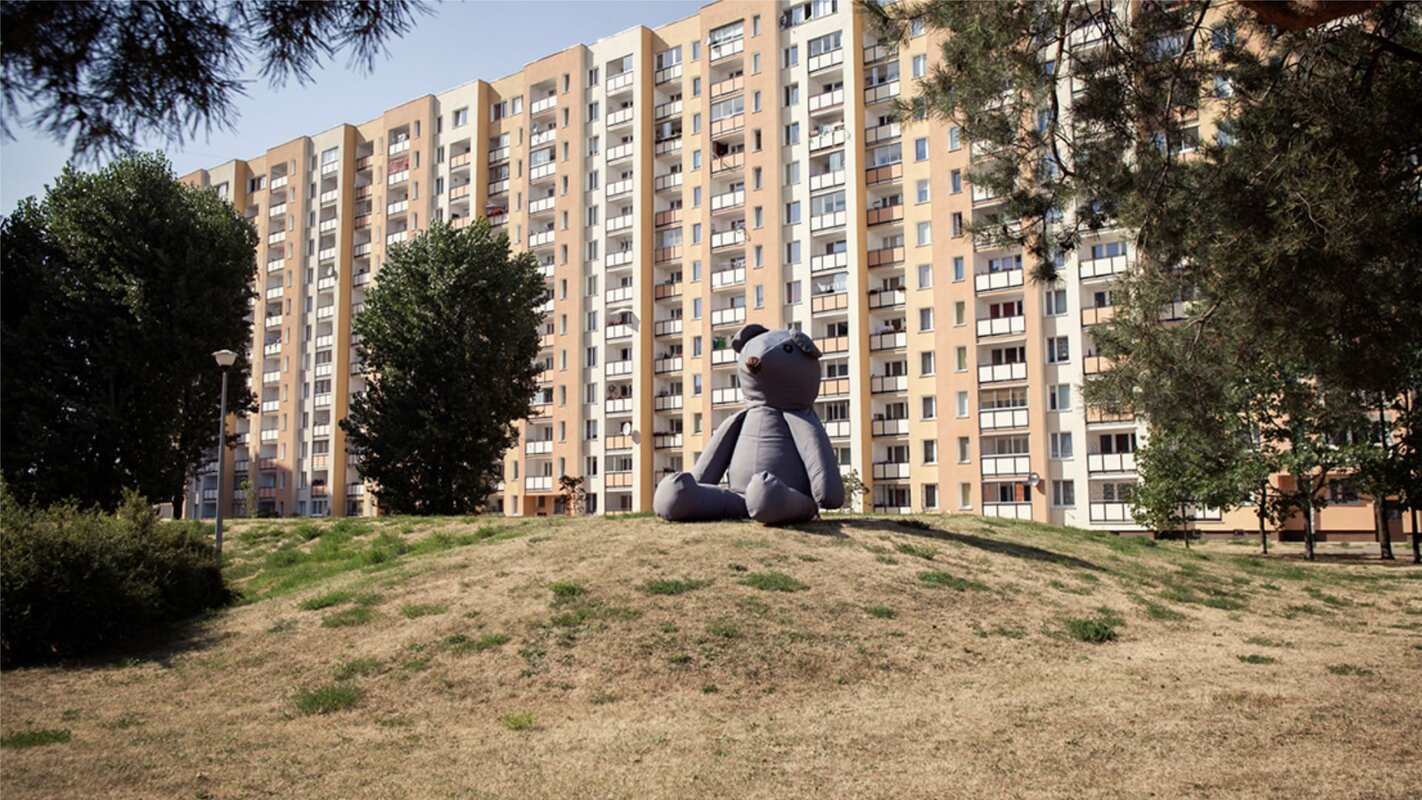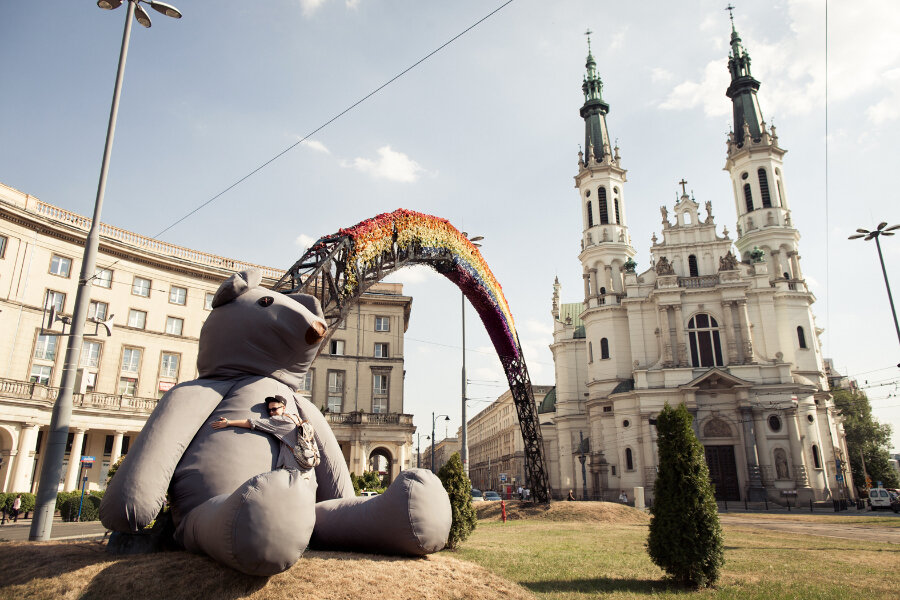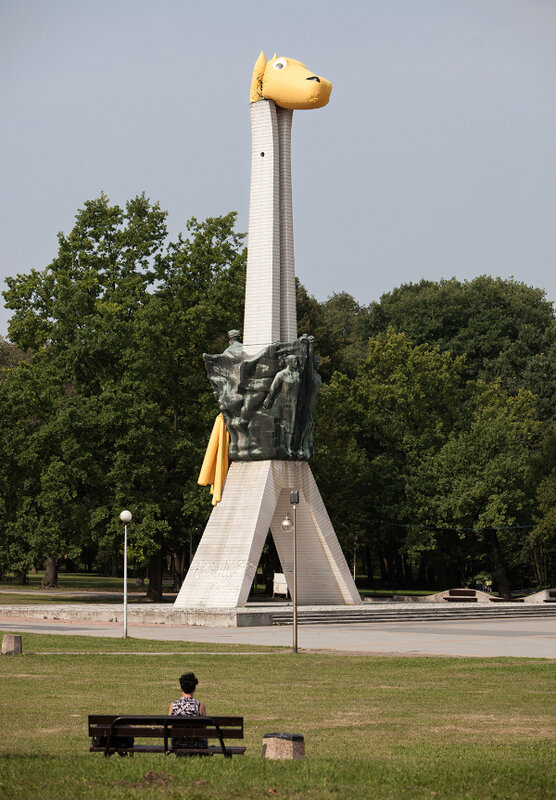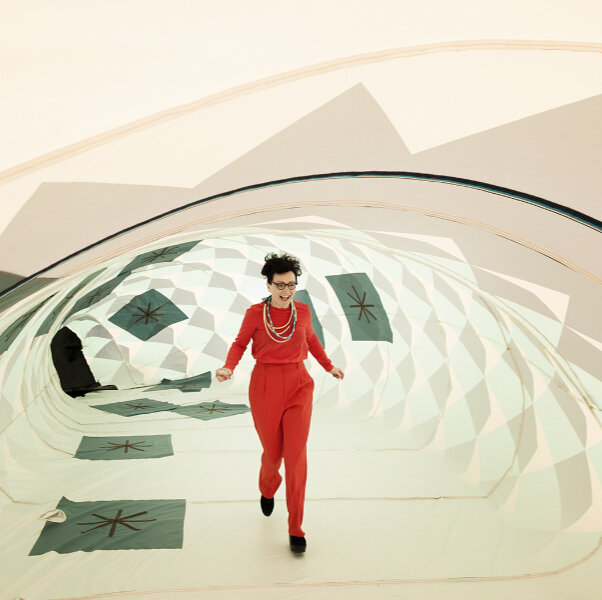
Iza Rutkowska: A GIANT TEDDY BEAR TRAVELING THE WORLD
Iza Rutkowska, a Polish visual artist, designer, educator and culture manager, uses artistic tools to integrate communities and instigate social change. She designs interactive objects in order to catalyze people’s energy. She creates playgrounds with children, backyards with residents, she transforms monuments into animals, and travels the world with a giant teddy bear. Living the dream? Her work has also its dark sides. We talked with her about how happy endings often require digging in your heels, about the pain of allowing your creation to have a life of its own, and why surprising people (while disguised as a tree) is the future of city planning.
Pictoplasma: Your bio picture on your website shows you lounging on a huge soft sculpture of a teddy bear.
Iza Rutkowska: My friends like to compare me with ‘The Cuddly,’ that’s the bear’s name. When people are around The Cuddly they act like kids, their thinking is less schematic and more spontaneous and joyful. And that’s usually how my friends behave around me as well.

Your work has a strong participative element to it. How important are children as participants in your art?
My initial intention never involved working with kids. Basically, my aim is to rekindle childhood memories and playfulness in adults. But when I started developing more projects, I noticed that the kids’ reactions were often so much more mature than anything I ever got from an adult, so I changed my mind. Strangely, while I try to get adults to be playful and revisit their inner child, my collaboration with kids is always very serious. I treat them like fellow artists, we design everything together, and we discuss things in depth. It works really well. At one point, I was thinking of opening an architect’s office—with kids only. But child labor is illegal, so I abandoned that idea.
Your projects are well documented on your website. The young participants working away on complex projects about architecture, art, and zoology all look deeply serious and concentrated.
Yes, kids cope very well with abstract thinking. Still, I would never dare to propose that we start working from a vague, open idea—even though that’s how I usually do things. Most of the time, when I set out I have no idea what direction a project will take. When working with adults that’s no problem, they are far more relaxed with that sort of approach, but I don’t feel I can motivate kids just by saying ‘Well, we’ll see what happens.’ I’d be afraid they might be disappointed by the end result if it didn’t turn out as planned.

How do you choose where to do a collaborative project and with whom?
The area is important. Sometimes curators approach me to work with a defined group of people. The elderly, for example, or feminist groups, but that’s not how I work. I prefer socially or culturally heterogeneous communities that cohabit in a particular place, and figuring out together with them what they’d like to do.
“… it’s very much what my work is about: bypassing stereotypes, breaking down prejudices, creating meeting points, and initiating collaborations that wouldn’t otherwise happen.”
For example?
In 2016 Wrocław was the European Capital of Culture. I was one of many other artists who were invited to work on site. When I arrived they handed me a map of the city and said: ‘This area could be relevant, it’s the place where things need doing the most.’ But I was free to go anywhere and do whatever I wanted. So I walked around the streets. I was a bit lost because everything was left completely up to me.
That can be exhausting.
It was! After a while I stumbled into a completely rundown backyard and met a few people. We started talking a bit and I thought it sounded interesting.
Why?
They told me that the head of Wrocław zoo, which is the biggest in Poland, lived in this backyard, but also some older people, a few kids, a couple of hooligans: a great mix of personalities living together—or rather next to one another. Trying to deal with that diversity is interesting to me, and it’s very much what my work is about: bypassing stereotypes, breaking down prejudices, creating meeting points, and initiating collaborations that wouldn’t otherwise happen.

How were you welcomed by the residents?
Last year we premiered a short documentary about the project, and we invited all the people who had taken part. After the screening there was some time for a discussion and one of the inhabitants talked about their first impressions of me: ‘We thought, she had come from Warsaw to teach us how to live, so we were not very keen on collaborating. But she was really stubborn. She just wouldn’t give up. So we felt we might as well just get on with it.’ Throughout the process it was very difficult to find ways to deal with each other, to communicate without conflict. But we managed it in the end and we had a great time. But it was actually quite hard at first.
“That was the moment when my architecture students and I invented the concept of ‘performative research’—a kind of costumed consultation.”
At some point during your projects you like to introduce inflatable sculptures like bricks, trees, and animals.
Yes, I bring in big costumes or objects that I’ve made that look like oversized toys.

What is their function?
They are tools for integrating people, bringing people together, magnetizing them. They also serve as what I call ‘performative research.’ The inflatable trees were actually costumes used during research into the problem of gated communities—Warsaw has been full of them since the end of the nineties. We wanted to find out why anyone would choose to live in such a closed off and shielded community. I thought it would be nice to create human fences out of people disguised as Thuja or cedar hedges and to single out people in these gated communities to ask them questions. We would appear out of nowhere, surround them, and wouldn’t let them go until they gave us answers. I believe the responses we got were far more expressive than if we’d been running around with a questionnaire.

So people played along?
Almost all of them started out by saying: ‘Sorry, I’m in a rush to get to work.’ But we said: ‘Sorry, you are trapped.’ So they started talking with us, which I think was also good for them. Forced out of their routine, they didn’t just use their heads, they started to feel. We had only one situation with a woman whose kid started to cry.
Tell me about the bricks.
That project was created around the time when plans for opening a new Pavilion of Architecture in Warsaw were being discussed, and we wanted to find out what people thought should be built in the area. That was the moment when my architecture students and I invented the concept of ‘performative research’—a kind of costumed consultation.
Who was wearing the costumes?
My students and me! We had a lot of discussions about what to wear—but they finally agreed to be bricks.
Now nobody will ever take them seriously again?
Well, at first they were not all too enthusiastic, like ‘Yeah, great, let’s do a little performance here!’ In Poland, there’s still a long way to go before people accept that this kind of research can be useful for rebuilding spaces. Actually I’m starting a PhD on this topic because I see a genuine need there. I sometimes collaborate with the city council, and they’re like: ‘Look, we’ll build five playgrounds here,’ and I’ll say: ‘But wait, people would rather have them over there.’ In architecture, I think that people are the most important factor. You first need to find out what they actually want. If you involve them from the outset they start to feel that it’s also made by them, then there’s this feeling of: it’s ours, we care about it. For example, the people in the backyard project are now completely rebuilding their backyard with city council funding. That’s a brilliant outcome.
“Watching people go crazy and jump on it was too much. I thought they would break it!”
The objects and sculptures you bring into your projects serve one function, but then get new ones through the people.
Yes, and to be honest, this was very hard for me at the beginning. You make something and you imagine what is going to happen, but then people do something completely different. I didn’t like it. When I first put The Cuddly downtown to see what would happen, I couldn’t cope. Watching people go crazy and jump on it was too much. I thought they would break it!

Did you try to stop them?
Hell no! I met Kurt Perschke, the author of the RedBall Project—he travels around the world with a giant inflatable red ball. I was complaining about The Cuddly and he said: ‘If you can’t let go, then maybe this sort of work is not for you.’ I said: ‘No way!’ Now I drop off The Cuddly somewhere and just go somewhere else while people have fun with it. I come back later, often to find that The Cuddly has been moved to some other, random part of the city.
People seem to love The Cuddly. But what kind of reactions do you get from the police?
The first time I placed it in Warsaw city center, it was without official permission—too much paper work. When the police arrived, I was sitting nearby, observing the goings on. They started taking pictures as if it were a car parked illegally. I thought I’d probably have to pay a fine. But in the end they just took a couple of selfies and left.

What a surprise!
I guess the police just don’t know how to react in these kinds of situations.
Like finding a 6-meter tall teddy bear?
Exactly. Same thing happened with the Thuja trees in the gated communities. The police showed up, got out their walkie-talkies to explain to their colleagues what was going on: ‘Yes, there are some green … er … I think they’re trees … surrounding us.’ Imagine them handing in their report!
Absurd.
Totally abstract. Since then The Cuddly has travelled to many places and countries, mostly without permission. It once almost made it into the Colosseum in Rome! But I have never once been given a fine. Maybe even the police enjoy the energy!

Interview by Elise Graton on the occasion of Pictoplasma Berlin, 2019
- 567 views
- 0x empathizes